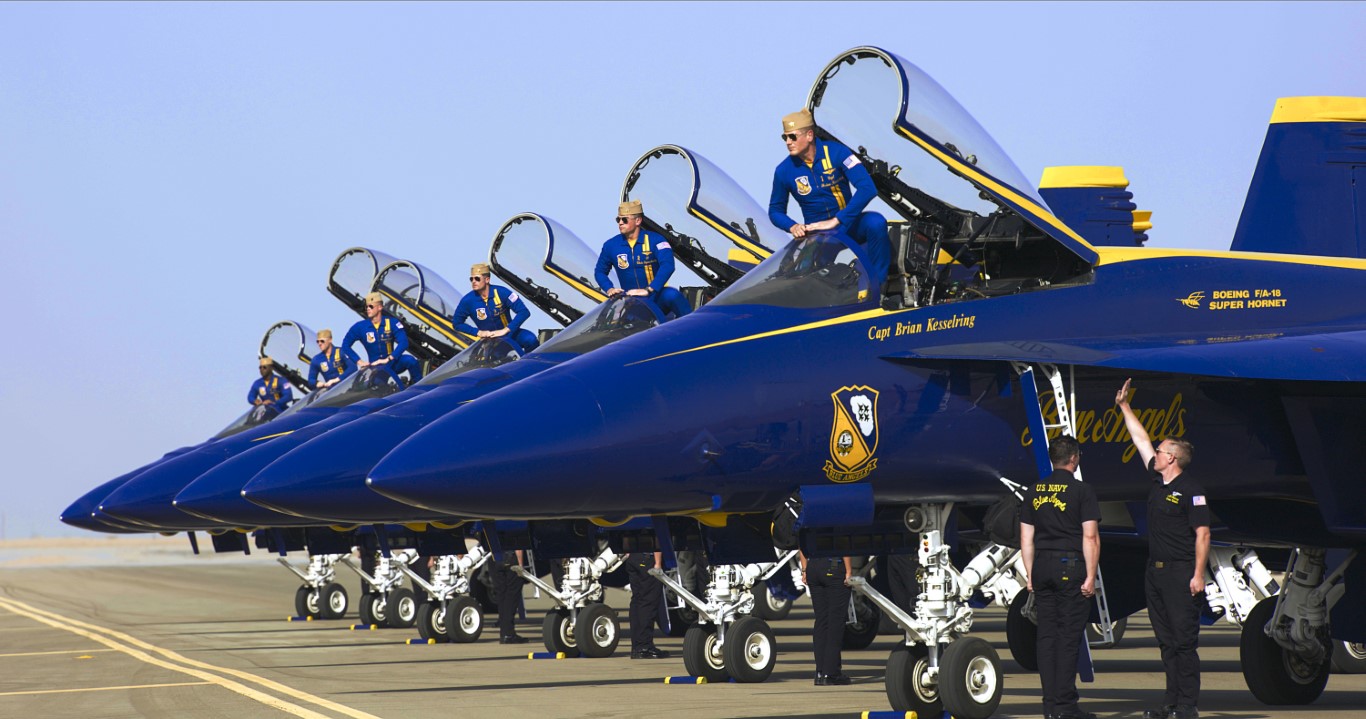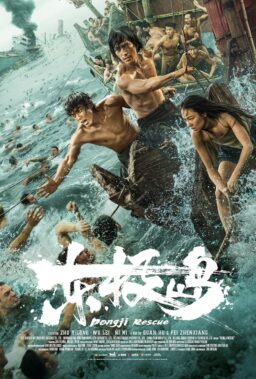Glen Powell played a military pilot in “Top Gun: Maverick” and “Devotion.” In his off-screen life, he is a pilot who has flown with the US Navy’s Blue Angels, in “Top Gun” terms, the best of the best of the best, who travel the country to demonstrate the excitement, precision, and power of naval aviation. Powell wanted to show audiences what he saw when flying in formation with the Blue Angels, so close that their wings touched. He produced an IMAX film that takes us into the air and behind the scenes as some pilots join the team and others complete their service.
In an interview with RogerEbert.com, he talks about the technical innovations that made the film possible, the difference between Navy and Marine call signs, and what he has learned as an actor by flying with the Blue Angels.
The cinematography in this film is extraordinary. I know IMAX cameras can be cumbersome and every ounce matters when you’re flying a plane. And they were all so close, yet we never got a glimpse of the other cameras. How could they get the footage that takes us inside the Blue Angels’ formations?
One of the entry points into this documentary was when I was talking to Brian Ferguson, who’s the liaison between Top Gun, the institution, and “Top Gun,” the movie. He connected me with Greg “Boss” Wooldridge, one of the most legendary Blue Angels bosses of all time and a producer on this film. Boss wanted to make a documentary, and as we were talking about what his vision for it was, I started thinking about my experience with aviation over the years prior, in “Top Gun or “Devotion” or becoming a pilot myself or flying with the Blue Angels.
Claudio Miranda really figured out how to break apart IMAX cameras on “Top Gun” to separate the lenses and the camera body. Since then, the IMAX cameras have gotten smaller and smaller and smaller. And so, what we had is this really rare moment for IMAX technology that we could put these cameras on planes where it’s not affecting the airworthiness, where you could fly it so close to the ground and sub-supersonic speeds, these visceral speeds that don’t make sense. It is a moment in filmmaking, the first time it’s ever been possible for audiences. So that’s pretty cool.
When I flew with the Blue Angels, I flew in the number four plane, which is the center of the hive. The four plane also does this incredible maneuver where you’re the inverted plane and the double four move. I was trying to describe to people what that was like, but it’s indescribable. I started realizing that I knew the aerial coordinator from “Top Gun.” I have a great relationship with the Navy. You know, I have the, you know, the ability to call great filmmakers. That can really plus this thing up. That’s the thing I’m the most proud of here. We have the most extraordinary team that came together. Paul Crowder, who directed it, really put audiences in the cockpit. The movie humanizes these pilots, showing us their families, what they give up, what they have to learn, and how they become a team.

I particularly loved it when you could see the reflections in the goggles. I wondered why I did not see the camera reflected there. It’s amazing that they could pull that off.
When I was flying with the Blue Angels, I kept referencing a picture I took, like a selfie in the jet, and you could see the Blue Angels, all these planes right in my sight line. I was like, “This shot is extraordinary.” And we kept referring to that shot, which is this feeling of what makes the Blue Angels different. They are so close they are literally scraping paint.
It’s just such an impressive thing to be near and around, and that’s what makes this documentary so different. One of my favorite parts about pre-production on a movie is that you get to invest in a new world, a community you’ve never been around. That was like the feeling that I had with “Top Gun: Maverick.” I felt like I understood the Naval aviation community in a way I’d never seen before. Then, when I got to fly with the Blues, there was a completely different pace and a completely different language happening in that briefing room.
One thing that struck me, which you see in the film, is this thing they do called chair flying. They literally sit in the briefing room, and they’re in the chair, imagining their left hand on the throttle, their right hand on the stick, and they fly the entire show with their eyes closed. I thought it was the coolest thing to watch how they speak to each other. These guys are flying at speeds and proximity that are unfathomable. That’s why they have to be able to fly with their eyes closed. That language has to be so baked into them, that cadence, the rhythm, these moves. It’s so precise and impressive. That is what I took from it.
The music in the movie, both the score and the songs, is so well chosen, which is not surprising given that Hans Zimmer produced it.
This is where I find that as a producer, your greatest asset is to assemble smarter people than you. We had the best in the business to come together for a common purpose and just watch the magic happen. Hans is obviously an icon, the best at what he does. I’ve had the privilege to work with him on a few movies at this point. So we had Hans Zimmer as our music producer and all of his lieutenants really guiding the musical force. And so, when you watch this documentary, musically, it puts you right in the cockpit.

There are many inspiring things that people say in the movie, but the one that really sticks with me is “Glad to be here.” What do you think that means to them, and what does it mean to you?
When I first saw the Blue Angels as a kid, it was one of the most impressive things I’d ever seen. The physics didn’t seem possible, and everyone around me had the same sense of wonder about it. But when they got on the ground, the pilots were shaking hands, signing autographs, and just being such incredible people. There’s this degree of humbleness that that defines a Blue Angel. They’re doing extraordinary things but doing it with such humbleness in their heart. For me, “Glad to be here” is such an emotional core of this documentary. Every single person who is on that plane knows what a privilege it is. They are the best of the best. They get a chance to represent the Navy and the United States and they do not take that responsibility lightly.
They have this one moment in the sun that I think is really defined in this documentary because it’s really about a baton handoff from one team to another. And so, you get this moment where you get to travel the world, and you get all these audiences around the world and all these crowds and really inspire people. And then you hand that job off to someone else, and they take that baton and become part of that same legacy.
“Glad to be here” just represents how special everybody who occupies that cockpit knows it is.
What did you learn from the Blue Angels that helps you as an actor or storyteller?
On a theatrical level, the theatrical experience of being in that theater and watching what we can do with technology is incredible. But for me, what’s even more impressive is that we were able to have access to the daily life of a Blue Angel, in terms of their family, how they wake up, and the sacrifice that they make being away 300 days out of the year. And what the human element of that pursuit of perfection looks like.
As an actor, it shows me that it doesn’t matter how big or impressive something is; it’s all about the heartbeat at the end of the day. This documentary has an amazing heartbeat because you get to know the men and women in these planes. The spectacle is obviously rewarding, but to understand the human beings in these cockpits, and to understand what it takes to make these things fly like that, that’s something that I’ll take on to every acting job.
One thing that’s very fun in this movie, as it is in “Top Gun,” are the call signs (official nicknames), which are so imaginative and fun.
My favorite part about being a part of the Naval Aviation community is waking up, looking at my phone, and having just half of them be call signs. It’s such a funny thing. People will look at my phone and say, “Who’s Nutterbutter? Who’s Toto? Who’s Stalin? Who’s McLovin?”
That’s what defines naval call signs, you know, compared to Air Force call signs. Air Force call signs are much more like Spine Ripper or Slayer, but Navy call signs always have a wink and a nod to them. It’s definitely a little more all-in fun.












